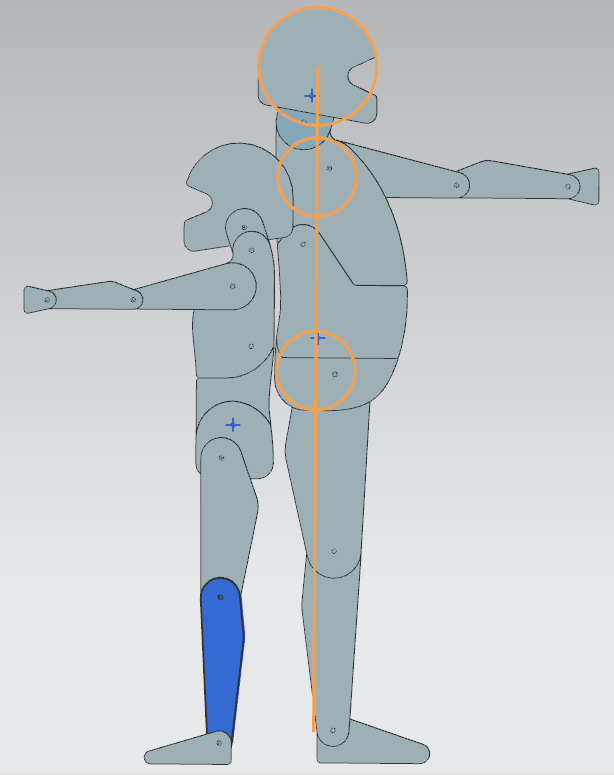Notes On Anthropometry
Via the University of Michigan Transportation Research Institute
They note the pelvis is too high in the above drawing.
Book excerpt: When the U.S. Air Force discovered the flaw of averages
EXCERPT report:
In 1950 an Air Force physician is asked whether current pilots are larger than the average pilot in 1926. After recording 140 different measurements on 4,000 pilots, he selects 10 key dimensions and looks for the number of pilots who are exactly average on all 10. He finds zero. He browbeats the Air Force bureaucracy and aircraft manufacturers who, after complaining about expense and difficulty, create inexpensive and simple adjustable seats, pedals, and harnesses. Planes stop crashing now that pilots can comfortably reach all controls.
Meanwhile, the Cleveland Health Museum runs a contest to find the woman who most closely matches the body measurements of the average, “ideal” woman. They find zero. They declare women are unfit, and aside from any methodical data collection, every detail of the story is offensive and ridiculous.
Anecdote:
One team 3D scanned the buttocks of all their drivers, took the average surface, and used that for their seat mold. It was the most uncomfortable seat any of them had ever used.
FSAE Tech Inspection:
Back when I participated in FSAE, the 95% percentile template (“Percy”) had no legs, so my team and others stuffed the torso down by the pedals to pass the helmet clearance rules. Tech Inspection began using actual tall men for final approval until Percy developed legs sometime after 2010.
Using Percy means Tech Inspection only has to check helmet clearance for exceptionally tall drivers. Per the rules, make sure you design around Percy’s foot resting on the pedal. Design in a little extra clearance in to save stress and account for build tolerance. Not passing Percy’s helmet clearance is nearly impossible to fix at competition, and those unfortunate teams will not pass Tech Inspection.
Performance Advantages:
A driver needs to be able to operate all the controls, or they will be unable to navigate a course. I could just reach full throttle in the first FSAE car I drove, but accelerating threw me backwards and off throttle, so that engine braking threw me forwards onto the throttle. Undrivable. Any body parts pressed onto an uncomfortable bump or sharp edge are only going to hurt. That’s not good for putting in a top-level drive day after day. The subjective feelings to maintain control at tire friction limits are beyond the scope of this article, but a driver feeling physically secure while able to repeatably, comfortably operate all controls has a better chance of consistently good laps. Don’t underestimate the psychological advantage of a car that feels right and fast before it’s even moving.
Don’t make the mistake of designing the controls around Percy. The idea is: 95% of people are smaller than that. Some large percentage of people (including me) wouldn’t be able to see over the wheel. The right approach is to adjust some combination of the pedals, steering wheel, and seat to one extreme for a 95% Percy, and adjust them to another extreme for a 5% Priscilla. Most everyone else will adjust to somewhere in the middle.
This is serious engineering, and we will all work with human factors for our entire careers. Even unmanned systems need to be assembled and serviced by people. Many teams build wood or PVC mock-ups to try out different seating positions for comfort, operation, and visibility. Here are some recommended joint angles to start with. Many teams can and do push to more acute joint angles, but they need to be even more careful not to run out of driver movement at 90 degrees or more of steering lock.
It’s worth getting a second opinion from people outside the team, for overall size as well as different body proportions. Try to engineer a little extra adjustment for both driver preference and the possibility some enormous or diminutive person will join the engineering or business side and be incredibly fast behind the wheel. There can be a calculable, measurable acceleration advantage to finding out who can launch the car the best, and trying to train the lightest team members to launch the same way. Also at competition, design judges come in all shapes and sizes. One or more judges will jump into your car during preliminaries. You need their vote to go to finals. Extra large and extra small drivers try out and score the fit in every finalist car.
We stand on the shoulders of giants:
As usual, there are incredible resources across dozens of web searches:
FSAE Anthropometric Reference Data
NASA Anthropometry And Biomechanics
Excerpts from Gordon et al, 1988 US Army ANSUR
Gordon et al, 2012 US Army ANSUR II
Anthropometric Dummy Family, Vol 1
National Anthropometry Survey Of Female Firefighters
Special thanks to Jim Embach and Igor Fischbein at Ford, for actually taking my call, having a great discussion, and joint angle recommendations.
Check my math:
Orange: Very good correlation with helmet rules template.
Google Sheets: Percy and Priscilla 2D Measurements
If you take all of the 95% measurements from different parts of the body and put them together, the total is much greater than 95% height. Height percentile has almost no correlation to the percentile of any other measurement. The gene interactions for any individual result in many different body proportions and percentiles depending on the measurement. As an extreme example, Olympic swimmer Michael Phelps (height 193cm) wears pants with an 81cm inseam, which are shorter than the pants worm by one-mile run world record holder Hicham El Guerrouj (height 175cm). In addition, 95% and any percentile height varies from country to country, region to region, and generation to generation (with nutrition as a significant influence.)
After going through every bit of publicly available data I could find, approximating spine pivot locations from pelvis to neck still took a great deal of guesswork. Most references are very serious and transparent about their data and use of statistics, but they still break down as soon as you try to extrapolate. Using 2 standard deviations from the average vertebrae measurements (Ogden, plus Austin) did not work at all. Conflicts between data sets are an opportunity to learn and probe assumptions, but ultimately, good engineering judgment has to decide what numbers to use. Given my limited knowledge of vertebrate evolution and sexual dimorphism, I tried to make the spine and pelvis angles as similar as possible. I ultimately settled on making everything proportional, except for 2 degrees more tilt from vertical of the female template’s pelvis. It’s a good sign that Flat Pack Percy and Priscilla look human to me, and I even know people who look like each. One outstanding concern is whether there should be curvature on the back of the torso, or at least a more forward neck position for reclined seating.
The other big complexities are skin, muscle and fat squishing into different shapes, especially seated versus standing. And skeletal joints tend to have much more complex movements than pinned connections. Picking a single non-deformable profile for thighs and buttocks, targeting good correlation through multiple seated and standing postures, results in a discontinuous and unnatural looking transition. Simplifying human forms and massively reducing the number of joint movements can be useful when tailored to specific situations, but must be done thoughtfully and carefully. Models of humans stop working as soon as you extrapolate.




